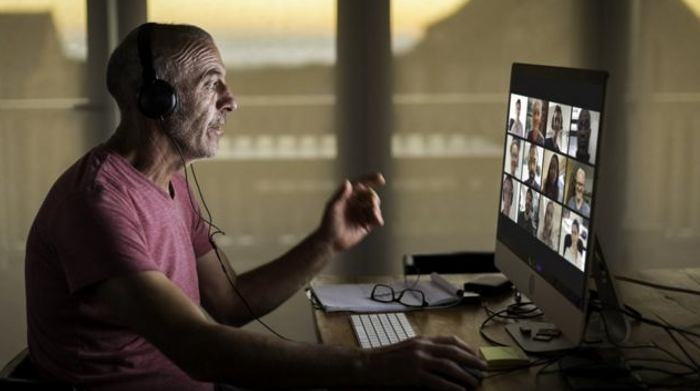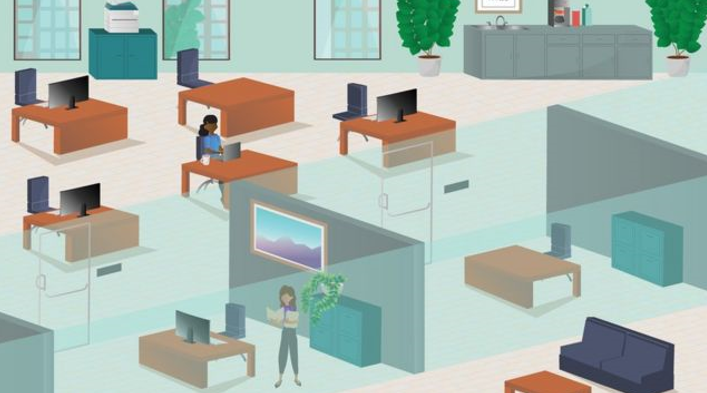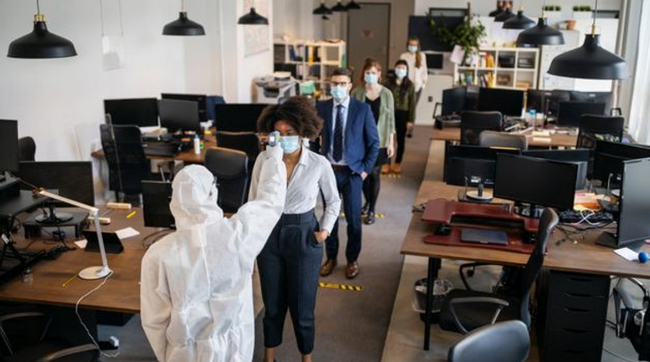homeoffice1
Covid x Work
Did the Home-Office came to stay?
Source
BBC, London
Home-Office
Covid Changes How To Work?
We bring a great interview of David Mott to BBC regarding the current scenario
Is the work office, as we have known it until now, a relic of the past?
David Mott, a venture capitalist, asked that question to himself as he reflected on the pandemic. He believes that the coronavirus has given us a "great opportunity for real historical change" and "reinventing the concept of the office".
Mott, a founding partner of Oxford Capital, a real estate investment firm in London, says that at many of his meetings in the past few months, he has discussed with his team what workspaces will look like going forward.
"And not only my company, but many of our customers - companies of all types, inside and outside the UK - are thinking about the future of work," he told BBC News Mundo, the BBC's Spanish service.
The office, says Mott, "is no longer the place where we are expected to spend fixed shifts with rigid meeting times. Most of us who worked in an office can work at home, in a cafe, at a friend's house or at a coworking. "
"Of course, for some professions, location is important. But office workers are seeing a blank page. We have an incredible opportunity to redefine the way we work and rewrite the rules."
But we have to be careful to get the "new normal" right, he says. "We need digital tools to help us with this."
Mott, passionate about the subject, did his own research and concluded that there are at least five new office models that are emerging in the world. "And more can come."
The BBC explained some of them.
1. The totally remote office
"We opened our eyes to the wonders of remote work. Zoom and other video call platforms are not perfect, but they freed us from the office. Digital nomads already did that and now we learned from their experiences. I traveled across Asia myself and felt confident that this system can work ", explains Mott.
"The home office is a real possibility for many businesses, but it requires a lot of work and a lot of technology to work well," explains the expert, who suggests options like Slack or Facebook Workplace.
"It's about looking for social tools so that people can interact."
"One of my companies started working remotely and created a 'social committee', a small group charged with making work more humane, close and fun, organizing online pizza nights and real experiences that people can share in."

Video conference meetings became common during the pandemic.
"I myself took part in a chocolate tasting through Zoom. We all received the chocolate in the mail and connected - about 20 people - with a specialist who provided the explanations. It was an incredible experience"
Mott believes that the main challenge of this model is the lack of contact with the team.
On the other hand, he explains that one of the main advantages is the possibility of new hires in distant places, "to expand talent", in addition to cost savings.
"All of these office models have pros and cons," he adds.
2. The hybrid model
This model consists of working one or two days a week at the office and the rest at a distance.
"That's what we decided to apply to my company," says Mott.
The company has 18 offices spread across the United Kingdom, in which some common and other individual spaces have been designed, adapted to the circumstances of the pandemic.
It is a model on which Marco Minervini, an organizational design researcher at the Insead business school in Singapore, is also betting. It is about combining remote work with office work, he says.
Although he points out that the model can accentuate some inequalities among workers, such as the quality of the internet connection and family situation.
Nicholas Bloom, professor of economics at Stanford University and specializing in remote work, told the BBC that two days of work at home a week is the ideal model for achieving a balance between personal and professional life, reducing stress and working time. displacement between case and office.

In some companies, only a limited number of employees (and wearing masks) can go to the office. However, it may not work for everyone, especially those who prefer a more established routine.
3. Remote 'plus' model
One week at the office, followed by three weeks working remotely.
"This model allows people to stay away, but make the effort to spend time working alongside your team once a month," says Mott.
It is not the most widespread model, but some large companies, such as Estée Lauder, decided to apply it soon after deliberating with employees.
"The company asked us which model we preferred and in the end what was the option", says Carolina Salvador, e-commerce coordinator at the London headquarters of the multinational Estée Lauder.
"In November we hope to reopen the London office, but only two floors, with a closed dining room and kitchen and no shared spaces. The use of a mask will be mandatory and we will have to reserve a place in the office before going. The maximum number of places is 100 people ".
She says that she believes that working from home "has many advantages, but being in the office and in contact with colleagues also has them. I am not less productive to work three weeks from home, but it is true that going to the office this week can be good. for teamwork. "
Measuring employee temperature can become commonplace.

4. Hub and Spoke
This model takes its name from a radial distribution paradigm, which expands from the center, like a kind of "rays" of the sun.
It consists of "expanding the company, with remote offices in other cities or countries, to take advantage of local skills", explains Mott.
"If, for example, 10 colleagues live in the same area, they can socialize more often in these spaces or put the WFA concept into practice (work wherever you want for as long as you want)".
That is, it is a variant of the hybrid office with more local options, depending on the team's layout.
5. Quality time
This fifth model concerns companies that prioritize production quality, without inspecting working hours so much: it doesn't matter if employees work from 9 am to 5 pm; each person is different and has their commitments. The important thing is the result of the work.
"There is flexibility to adapt work to other commitments, instead of subordinating family life to work commitments", sums up Mott.
"The flip side of the flexible working coin is that we really have to trust our colleagues and employees. When people are at home, we don't know what they are doing all the time. That's why this model requires a high level of trust. ".
"But who doesn't like confidence at work? I wouldn't be happy in my organization if people didn't trust me."
Credit, Basak Gurbuz Derman / Getty Images
Photo caption,
Regularly cleaning the keyboard is necessary in times of pandemic
But what about the 'past' office?
"When I started to reflect on this, I asked myself: what is an office?", Explains Mott to the BBC.
If we look back, we see that the first office was created on December 31, 1600 by the British East India Company. In it, rows of employees did the accounting and administration of the company.
"The model hasn't changed much," says Mott. "Hundreds of years have passed and we see how everything has remained practically the same."
New technologies have driven changes in the way of working and in productivity, but not so much in workspaces. First came typewriters and photocopiers, then computers.
But the routine in the office remained more or less the same.
Mott says his grandfather worked at IBM when electronic typewriters started being replaced by computers. And he himself began his career by adding columns of handwritten numbers with a calculator, before Excel tables and computers arrived.
Then came the internet.
"Of course, the digital revolution has changed a lot in the last 10 or 20 years. Some companies like Google, Facebook or Bloomberg have invested in really modern and innovative offices - some say that this was for people to stay in the office longer - but that it's a thing of the past ", ponders the investor.
The real change, according to him and other experts in the field, is now coming, with the pandemic.
"The habit of going to work in an office every day has changed, and when a habit breaks, you can create a new one. The era of the permanent table is over," sums up Mott.
The Chartered Institute of Personnel and Development, a human resources association based in London, predicts that most companies will maintain their physical offices.
But that does not mean that the way of working will not change, the organization's director Peter Cheese recently told the BBC: "The pandemic is forcing employers to think differently about the feasibility of allowing their employees to work flexibly."
"We live in a moment of real changes in the world of work driven by an existential crisis", explains Cheese.
And this shift puts employees at the center of strategic decisions like never before.
